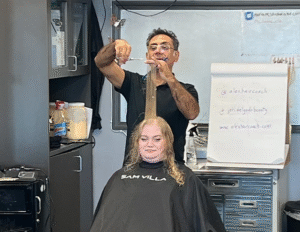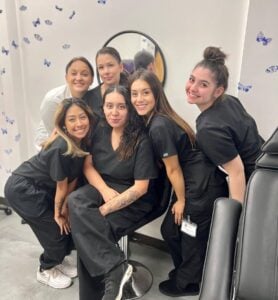Quick Answer: Barber school typically takes 10-12 months full-time or 12-18 months part-time to complete the required 1,000-1,800 hours (varies by state). In Illinois, you need 1,500 hours, which takes about 10-12 months full-time. Graduates earn a median wage of $18.73/hour ($38,960 annually), with job growth projected at 7% through 2033.
If you’re passionate about precision haircuts, classic shaves, and building relationships with clients, barbering offers an excellent career path with strong job security and earning potential. One of the most common questions aspiring barbers ask is: “How long does barber school take?”
This comprehensive guide covers everything you need to know about barber school duration, costs, career prospects, and what to expect from your training.

How Long Is Barber School in Illinois (and Nationwide)?
Barber school duration varies significantly by state, with required hours ranging from 500 to 1,800. Here’s a comprehensive breakdown:
| State | Required Hours | Full-Time Duration | Part-Time Duration | Median Annual Salary |
|---|---|---|---|---|
| Illinois | 1,500 hours | 10-12 months | 12-18 months | $38,960 |
| California | 1,000 hours | 7-8 months | 10-12 months | $44,200 |
| Texas | 1,000 hours | 7-8 months | 10-12 months | $35,840 |
| Florida | 900 hours | 6-7 months | 9-11 months | $32,180 |
| New York | 500 hours | 3.5-4 months | 6-8 months | $48,100 |
| Georgia | 1,500 hours | 10-12 months | 12-18 months | $34,920 |
| Ohio | 1,800 hours | 12-14 months | 15-20 months | $36,440 |
| North Carolina | 1,528 hours | 11-13 months | 14-18 months | $33,760 |
| Nevada | 1,500 hours | 10-12 months | 12-18 months | $42,180 |
| Michigan | 1,800 hours | 12-14 months | 15-20 months | $37,620 |
| Pennsylvania | 1,250 hours | 8-10 months | 11-14 months | $39,280 |
| Arizona | 1,200 hours | 8-9 months | 11-13 months | $35,200 |
| Washington | 1,000 hours | 7-8 months | 10-12 months | $55,980 |
Why the Median Salary Appears Modest
- Reported figures often exclude tips:
The Bureau of Labor Statistics and salary sites usually count only base wages, but barbers make a significant portion of their income from tips, sometimes adding 20–50%+ to their take-home pay.
Program Length Based on Schedule:
- Full-time students: ~10 to 12 months
- Part-time students: ~12 to 18 months
- Evening/weekend schedules: Varies depending on class availability
🎓 At Cosmetology & Spa Academy, our barbering program is designed to offer flexible schedules that fit your lifestyle.
Factors Affecting Your Timeline
Schedule Intensity:
- Full-time programs: 30-40 hours per week, faster completion
- Part-time programs: 15-25 hours per week, more flexibility
- Evening/weekend schedules: Accommodate working students
Individual Factors:
- Attendance and punctuality
- Previous experience or education
- Time to pass state board exams
- Whether you need remedial coursework
Program Structure:
- Intensive/accelerated programs: Some schools offer fast-track options
- Traditional programs: Standard pace with balanced theory and practice
- Flexible programs: Self-paced or hybrid learning models
The Complete Path to Becoming a Licensed Barber
Step-by-Step Timeline
1. Enrollment and Pre-Requirements (1-2 weeks)
- High school diploma or GED verification
- Age requirements (typically 16-18 years old)
- Application and enrollment process
- Financial aid processing (if applicable)
2. Barber School Training (6-18 months)
- Complete state-required hours
- Pass all theoretical and practical coursework
- Build portfolio of work
- Prepare for state board exams
3. State Board Licensing (2-8 weeks)
- Submit licensing application
- Pass written exam (theory-based)
- Pass practical exam (hands-on demonstration)
- Pay licensing fees ($50-$200 depending on state)
4. Job Search and Career Launch (2-12 weeks)
- Build professional portfolio
- Apply to barbershops and salons
- Network with industry professionals
- Begin building clientele
Total Time from Start to Working: 8-20 months depending on state and program intensity.
What You Learn in Barber School: Comprehensive Curriculum
Barbering is more than just cutting hair. This profession has to do with mastering precision and creativity as well as client communication. Our program offers hands-on training in both technical and business aspects of the industry.
Core Technical Skills (60% of curriculum)
Hair Services:
- Men’s haircuts and styling techniques
- Clipper work and fading methods
- Scissor cutting and texturizing
- Hair washing and conditioning
- Basic hair coloring and highlighting
Shaving and Facial Hair:
- Straight razor shaving techniques
- Safety razor procedures
- Beard trimming and shaping
- Mustache styling
- Hot towel treatments
- Basic facial treatments
Sanitation and Safety:
- Infection control procedures
- Tool sterilization methods
- Chemical safety protocols
- State health regulations
- Workplace safety standards
Theoretical Knowledge (25% of curriculum)
- Hair and scalp anatomy
- Chemistry of hair products
- Skin conditions and treatments
- Color theory and application
- State laws and regulations
- Professional ethics
Business and Professional Skills (15% of curriculum)
- Client consultation techniques
- Customer service excellence
- Appointment scheduling
- Retail sales and upselling
- Social media marketing
- Basic business operations
- Resume building and job search strategies
Financial Investment and Return Analysis
Barber School Costs Breakdown
Tuition Ranges:
- Community colleges: $3,000-$8,000
- Private trade schools: $8,000-$20,000
- Specialty barber academies: $10,000-$25,000
Additional Costs:
- Student kit and tools: $1,000-$3,000
- Textbooks and materials: $300-$800
- State board exam fees: $75-$250
- Initial licensing fees: $50-$200
- Continuing education: $200-$500 annually
Total Investment Range: $4,500-$29,000
Return on Investment Analysis
Starting Salary Expectations:
- Entry-level (0-1 years): $25,000-$35,000 annually
- Experienced (2-5 years): $35,000-$50,000 annually
- Established (5+ years): $45,000-$80,000+ annually
Bureau of Labor Statistics Data (2024):
- Median hourly wage: $18.73 ($38,960 annually)
- Lowest 10%: $13.35/hour ($27,760 annually)
- Highest 10%: $37.71/hour ($78,440 annually)
High-Earning Potential:
- Master barbers: $54,407 average salary
- Salon owners: $60,000-$150,000+ annually
- Specialty services (straight razor, beard design): Premium pricing
Break-Even Timeline: Most barbers recoup their educational investment within 2-3 years
Payment Methods and Income Potential
Employment Structures:
- Hourly employee: $13-$25/hour plus tips
- Commission-based: 40-60% of service fees
- Booth rental: Keep 100% of earnings, pay rent ($100-$400/week)
- Business owner: Unlimited potential, higher responsibility
Tips and Additional Income:
Specialty services: Premium pricing opportunities
Tips typically add 15-25% to base income
Retail product sales: Additional commission

Career Opportunities and Job Market Analysis
Employment Outlook (2023-2033)
Job Growth Statistics:
- Overall growth rate: 7% (faster than average for all occupations)
- New job openings: Approximately 89,100 annually
- Current employment: Over 12,880 barbers nationwide
- Active job openings: 2,823+ positions available
Driving Factors:
- Growing male grooming market
- Increased interest in traditional barbering services
- Rising disposable income for personal care
- Retirement of aging barbers creating openings
Career Paths and Specializations
Traditional Employment:
- Full-service barbershops
- High-end men’s salons
- Hotel and resort spas
- Military base barbershops
- Retirement communities
Entrepreneurial Opportunities:
- Independent barbershop owner
- Mobile barbering services
- Specialty services (weddings, events)
- Franchise ownership
- Multi-location business development
Alternative Career Paths:
- Barber instructor at schools
- Product sales representative
- Platform artist for brands
- Competition barber
- Social media influencer/educator
Specialization Options:
- Straight razor specialist
- Beard and mustache expert
- Vintage/classic styling
- Modern fade techniques
- Scalp treatments and therapy
Barber vs. Cosmetology: Making the Right Choice
Key Differences
| Aspect | Barbering | Cosmetology |
|---|---|---|
| Focus | Men’s hair and grooming | Full beauty services |
| Training Hours | 500-1,800 hours | 1,000-2,000 hours |
| Duration | 6-18 months | 9-24 months |
| Services | Haircuts, shaves, basic styling | Hair, nails, skincare, makeup |
| Client Base | Primarily male | All genders |
| Specializations | Fades, shaves, beard work | Color, perms, advanced styling |
| Equipment | Clippers, razors, basic tools | Extensive tool collection |
| Income Potential | $25,000-$80,000+ | $25,000-$75,000+ |
Choose Barbering If You:
- Prefer working primarily with male clients
- Enjoy precision cutting and classic techniques
- Want to master straight razor shaving
- Prefer shorter, focused training
- Like traditional barbershop atmosphere
- Want to specialize in men’s grooming trends
Consider Cosmetology If You:
- Want more flexibility in career paths
- Want broader service options
- Enjoy working with diverse clientele
- Interested in color and chemical services
- Prefer variety in daily tasks
State-Specific Requirements and Considerations
Illinois Barber Licensing Requirements
Education Requirements:
- Complete 1,500 hours at state-approved school
- OR complete 3,000-hour apprenticeship program
- Minimum age: 17 years old
- High school diploma or equivalent
Examination Requirements:
- Written examination only (Illinois doesn’t require practical exam)
- Passing score: 75% or higher
- Topics covered: Theory, regulations, safety, sanitation
Licensing Fees:
- Initial license: $50
- License renewal: $50 (every 2 years)
- Late renewal penalty: $25
Reciprocity and License Transfer
States with Illinois Reciprocity: Many states accept Illinois barber licenses with minimal additional requirements. Always verify current reciprocity agreements before relocating.
Transfer Process:
- Apply for license by endorsement
- Provide proof of current Illinois license
- May need to pass state-specific law exam
- Pay applicable fees
- Meet continuing education requirements
Accelerating Your Barber School Journey
Fast-Track Options
Intensive Programs:
- 40+ hours per week
- Complete 1,500 hours in 8-9 months
- Requires full-time commitment
- Higher daily workload
Credit for Prior Experience:
- Cosmetology license holders may receive reduced hour requirements
- Military grooming experience may count toward hours
- Previous apprenticeship work may transfer
Summer Programs:
- Accelerated summer schedules
- Complete more hours in shorter timeframe
- Ideal for students with summer availability
Success Strategies
Academic Excellence:
- Maintain perfect attendance
- Complete assignments ahead of schedule
- Seek additional practice opportunities
- Build relationships with instructors
Networking:
- Connect with classmates and alumni
- Attend industry events and trade shows
- Follow local barbershops on social media
- Volunteer for community events
Skill Development:
- Practice outside of class hours
- Study current men’s grooming trends
- Watch online tutorials and demonstrations
- Experiment with different techniques
How Long Does It Take to Get a Barber License?
Completing your training hours is just one part of the journey. To become a licensed barber in Illinois, you must also pass the Illinois State Board licensing exam, which includes both written and practical components.
The full path to licensing includes:
- Enroll in a licensed barbering program
- Complete 1,500 training hours
- Pass the state board exam
- Apply for your state barber license
If you attend full-time, you can typically earn your license and begin working in under a year.
Can You Become a Barber Faster?
Some students may be able to accelerate their training by attending more hours per week or choosing an intensive schedule. However, the Illinois State Board still requires the full 1,500 hours, so your actual timeline depends on your attendance and course load.
Factors that affect how fast you will be able to finish your barbering program:
- Your chosen schedule (daytime, evening, part-time)
- Class attendance and punctuality
- How soon you pass your licensing exam
⚡ Contact us and ask our admissions team about fast-track options or customized schedules to help you reach your goals.

Barber School vs. Cosmetology School: What’s the Difference?
While both programs teach foundational hair skills, barbering and cosmetology serve different client needs and offer different experiences.
Barber School focuses on:
- Men’s haircuts and styles
- Beard and facial hair grooming
- Straight razor shaving
- Clipper techniques and fades
Cosmetology covers:
- Women’s and men’s hair styling
- Skincare, facials, and waxing
- Nail care and makeup artistry
If you want to perfect fades, shaves and men’s grooming, barber school is the best fit. If you want to explore a wider range of beauty services, consider cosmetology.
What Happens After Barber School? (Career Outlook)
Once you’re licensed as a professional barber, a range of opportunities becomes available. You can work in:
- Traditional barbershops
- Upscale salons
- Men’s grooming lounges
- Spas and resorts
- As a freelance or mobile barber
- Or even open your own shop
According to the U.S. Bureau of Labor Statistics, the demand for barbers is projected to grow 7 percent from 2023 to 2033, faster than the average for all occupations, with increased interest in men’s grooming and style services.

Frequently Asked Questions
Education and Training
How long is barber school in Illinois? In Illinois, barber school requires 1,500 hours of training, which typically takes 10-12 months for full-time students or 12-18 months for part-time students.
Can I attend barber school part-time? Yes, most barber schools offer part-time schedules including evening and weekend classes to accommodate working students and those with family obligations.
Do I need a high school diploma to enroll? Yes, most states require a high school diploma or GED equivalent. Some states accept students who have completed at least 10th grade with parental consent.
Can I transfer hours from cosmetology school? Many states allow partial transfer of cosmetology hours toward barber training. The number of transferable hours varies by state, often reducing requirements by 200-500 hours.
Is financial aid available for barber school? Yes, accredited barber schools typically qualify for federal financial aid including Pell Grants, student loans, and work-study programs. Many schools also offer payment plans and scholarships.
Licensing and Career
What kind of license do I get after barber school? You’ll earn a state barber license issued by your state’s licensing board (in Illinois, it’s the Department of Financial and Professional Regulation).
Can I work in other states with my barber license? Many states have reciprocity agreements allowing licensed barbers to transfer their license. You may need to pass additional exams or meet specific requirements.
What’s the job outlook for barbers? Very positive. The Bureau of Labor Statistics projects 7% job growth for barbers from 2023-2033, faster than the average for all occupations.
How much can I expect to earn as a new barber? New barbers typically earn $25,000-$35,000 annually. With experience and an established client base, earnings can reach $45,000-$80,000+ per year.
Is barber school harder than cosmetology school? Neither is necessarily “harder,” but they focus on different skills. Barbering is more specialized, while cosmetology covers a broader range of services. Your success depends on your interests and learning style.
Practical Considerations
Do I need my own tools for school? Most schools provide a professional student kit as part of tuition, including clippers, scissors, razors, and other essential tools.
Can I open my own barbershop immediately after graduation? While legally possible after licensing, most successful shop owners gain 3-5 years of experience working for others before starting their own business.
What’s the difference between booth rental and employment? Employment provides steady income but less flexibility. Booth rental offers more independence and higher earning potential but requires you to build your own clientele and handle business expenses.
Will I get help finding a job after graduation? Reputable schools provide career services including resume assistance, interview preparation, job placement help, and connections with local employers.
How long does it take to build a steady clientele? Most barbers report it takes 1-3 years to build a loyal, steady clientele that provides consistent income. Success depends on location, skill level, and marketing efforts.
Are there opportunities for advancement in barbering? Yes, career advancement includes becoming a master barber, opening your own shop, teaching at barber schools, becoming a platform artist, or specializing in high-demand services.
The Bottom Line: Is Barber School Worth It?
If you’re looking for a career where you can work with your hands, connect with people, build an independent career and enjoy flexibility in your work, barber school is absolutely worth it. In less than a year, you could be licensed, working and building your own client base.
At Cosmetology & Spa Academy, you’ll be part of a school that combines:
- Over 30 years of industry experience
- Supportive instructors and classmates
- Real-world training with real clients
- Career guidance and job placement services
💈 Think barbering is your calling? Apply Now to start your journey.
📞 Call: 815-455-5900
📧 Email: info@csa.edu
















